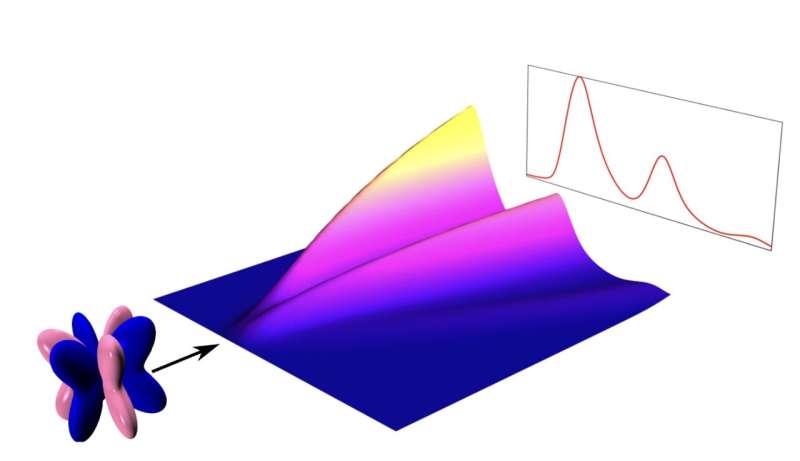March 22, 2024 feature
This article has been reviewed according to Science X's editorial process and policies. Editors have highlighted the following attributes while ensuring the content's credibility:
fact-checked
peer-reviewed publication
trusted source
proofread
Study outlines spectroscopic signatures of fractionalization in octupolar quantum spin ice

Quantum spin liquids are fascinating quantum systems that have recently attracted significant research attention. These systems are characterized by a strong competition between interactions, which prevents the establishment of a long-range magnetic order, such as that observed in conventional magnets, where all spins align along the same direction to produce a net magnetic field.
Researchers at the University of Toronto recently introduced a framework that could facilitate the experimental observation of a new 3D quantum spin liquid known as π-flux octupolar quantum spin ice (π-O-QSI). Their paper, published in Physical Review Letters, predicts the distinctive spectroscopic signatures of this system, which could be measured in future experiments.
"Interestingly, quantum spin liquids can host fractionalized excitations," Félix Desrochers, co-author of the paper, told Phys.org. "Namely, the electrons in these materials appear to dissociate into multiple components. For instance, while electrons carry both spin and charge, the emergent quasiparticle can carry spin but no charge.
"These excitations do not arise from the fragmentation of the electrons into several pieces but are instead the result of a highly nontrivial form of collective motion induced by their strong interactions."
Physicists have been searching for clear examples of the quantum spin liquid state for decades. Nonetheless, progress in this field of research has been slow so far, due to two primary factors.
First, devising theoretical models that realistically describe spin liquid ground states and that can be used to derive accurate predictions has proved challenging. Second, detecting and characterizing the physical properties of these systems in real materials also proved difficult.
"Quantum spin ice (QSI) is a rare example of a model with a well-understood quantum spin liquid ground state and can also be found in a real material (like the family of rare-earth pyrochlores)," Desrochers explained.
"QSI is extraordinary as it realizes the lattice equivalent of quantum electrodynamics: it hosts emergent photon-like modes (i.e., excitations similar to particles of light), particles analogous to electrostatic charges with mutual Coulomb interaction known as spinons and even magnetic monopoles."
Based on theoretical predictions, the quantum electrodynamics emerging in QSI differ significantly from conventional electrodynamics. For example, the speed of the so-called "emergent light" should be in the order of 1 m/s, as opposed to the 3x108 m/s of light we encounter in everyday life.
"Recent experiments on Ce2Zr2O7, Ce2Sn2O7 and Ce2Hf2O7 have been extremely exciting," Desrochers said. "The materials do not show any sign of ordering down to the lowest accessible temperature.

"Further analyses determined the microscopic parameters describing its behavior. They found that the system is in a region of parameter space that is theoretically suggested to host a specific flavor of QSI known as π-flux quantum spin ice (π-QSI)."
While recent studies gathered encouraging findings, reliably identifying quantum spin liquids is a highly complex task, as even a weak disorder could potentially disrupt these states. To detect these states unambiguously, researchers first need to identify distinctive signatures that are specific to a quantum spin liquid, which remain stable.
"Prior to our work, there was no clear proposal for smoking-gun signatures of the spin dynamics in π-flux QSI," Desrochers explained. "Our work thus aimed to highlight potential distinct signatures that could help identify if π-flux QSI is realized in Ce2Zr2O7 and other similar compounds. We especially focused on signatures that could be measured with currently available experimental apparatus."
As part of their study, Desrochers and his Ph.D. supervisor Yong Baek Kim set out to predict the distinctive spectroscopic signatures of the π-flux QSI state using a theoretical framework introduced by Lucile Savary and Leon Balents in 2012, known as gauge mean-field theory (GMFT). This framework essentially rewrites initial spin operators based on the emergent excitations present in quantum spin ice, namely photons and spinons.
"This framework was already used to study π-flux QSI in some of the earliest works utilizing GMFT," Desrochers said. "We have thus expanded on this work with the aim of making experimentally meaningful predictions. To ensure our predictions are reliable, we have also made extensive comparisons with previous numerical results from our group and the literature."
This recent study by Desrochers and Kim offers a meaningful prediction of the distinctive spectroscopic signatures of the spin liquid state π-flux QSI. These signatures could guide future experimental studies, helping physicists to confirm the presence of this exotic state.
"We highlighted that π-flux QSI should produce three peaks of decreasing intensity in inelastic neutron scattering," Desrochers said. "This is a unique and distinctive signature. If measured, these three peaks would provide compelling evidence for the experimental realization of this three-dimensional QSL."
Desrochers and Kim hope that their predictions will help researchers to determine what they should expect to measure when encountering the elusive π-flux QSI state. Notably, the spectroscopic signatures they identified should be detectable at currently achievable experimental resolutions, thus they could potentially be observed soon.
Meanwhile, the researchers plan to build on their recent study to gather increasingly detailed predictions. For instance, they would like to study how the peaks they predicted would evolve at different temperatures and estimate at what temperatures they disappear.
"The most exciting future developments will surely come from the experimental side," Desrochers added. "Confirmation of the presence of these peaks would offer highly persuasive evidence of the realization of this long-sought-after new state of matter. There are already some encouraging signs: recent work on Ce2Sn2O7 reported measurements that show signs of three peaks of decreasing intensity."
More information: Félix Desrochers et al, Spectroscopic Signatures of Fractionalization in Octupolar Quantum Spin Ice, Physical Review Letters (2024). DOI: 10.1103/PhysRevLett.132.066502. On arXiv: DOI: 10.48550/arxiv.2301.05240
Journal information: Physical Review Letters , arXiv
© 2024 Science X Network





















